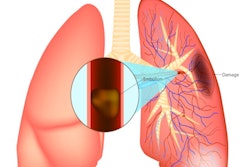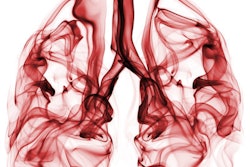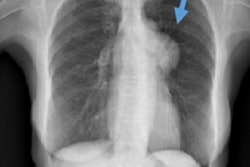
Using a CT-based computational model to determine the ventilation heterogeneity of chronic obstructive pulmonary disease (COPD) with increased detail can improve the stratification of these patients according to their disease severity and evaluate their suitability for regional treatment, researchers from Oxford, U.K., have found.
Radiologists at the Churchill Hospital and colleagues from the departments of engineering science and oncology at the University of Oxford have reported success with a full-scale airway network (FAN) model that uses structural imaging data to provide valuable insight into pulmonary function.
"The ventilation assessed by the FAN model showed statistically significant correlation with the pulmonary functional imaging data," noted corresponding author and consultant radiologist Prof. Fergus Gleeson and colleagues in an e-poster to be presented at the upcoming congress organized by the European Society of Thoracic Imaging (ESTI) and the Fleischner Society. The meeting begins in Paris on 9 May, but the e-posters are available in advance through the Electronic Presentation Online System (EPOS) section of the European Society of Radiology website.
Lack of functional information
Thoracic CT is an established diagnostic technique to detect structural pulmonary abnormalities, and although CT examinations are routinely performed clinically, the modality provides no functional pulmonary information, the authors explained.
Therefore, their study aimed to demonstrate the use of the CT-based FAN flow model to assess ventilation in COPD patients and to compare the modeling results obtained with hyperpolarized xenon-129 (HPX) MRI and SPECT imaging data.
They used the FAN flow model to assess pulmonary ventilation in nine COPD patients. A thoracic CT scan was performed on a Discovery 670 scanner (GE Healthcare) after the inspiration of air in a supine position while no data were acquired in expiration. The geometries of lobe surfaces and large airways until the fifth to eighth generation were segmented from the patients' CT images.
"Small airways were generated in the branch growing algorithm. Pulmonary tissue density information extracted from CT images and the lung function test results of these patients were applied to the initial lung stretch ratio and input flow boundary conditions of the model," pointed out Gleeson, a senior researcher in the National Institute for Health Research Oxford Biomedical Research Centre's Imaging Theme, and colleagues. "The FAN model resolved the dynamic airway flows and the gas concentration transfers."
The researchers compared the inspired gas ventilations calculated in the model with the functional imaging data, obtained from the acquisition of breath-hold time sequential HPX-MR and ventilation SPECT (V-SPECT) imaging. They used a 1.5-tesla MRI system (Signa HDx, GE) to acquire the HPX images, and they acquired time-series HPX images on 13 coronal slices using a flexible vest-shaped transmit-receive radiofrequency coil from Clinical MR Solutions.
Gleeson and colleagues acquired V-SPECT images according to the local standard protocol (Discovery 670 SPECT/CT). They reconstructed and attenuated the scanned images with the accompanying acquired low-dose CT scans. The lobar ventilation ratio from the V-SPECT images was determined as the ratio of the signal sum in each lobe.
The ventilation maps and line profiles were projected as a coronal plane of the model and compared with those obtained from the HPX-MR and the SPECT images. Additionally, the investigators compared ventilation distribution within the volumes of interest (VOIs) of the models with the functional lung images, and the lobar percentage ventilation parameters calculated by the FAN model were compared with the flow data estimated by HPX-MRI and SPECT.
These were the group's main findings:
- The pulmonary function calculated from the FAN model showed close similarity in ventilation distribution and location of ventilation defects when compared with the HPX-MRI and SPECT data.
- The Pearson correlations of the ventilation profiles on the projected plane between the model and images were statistically significant. The overall Pearson correlation coefficients for all patients included in the study were rMod-HPX = 0.67 ± 0.23, rMod-SPE = 0.61 ± 0.22, and rHPX-SPE = 0.69 ± 0.20.
- The probability histograms of ventilation distributions in the VOIs of the model and images revealed similar characteristics. Accordingly, the chi-square distances between the histograms were small. The chi-square distances between the model and HPX-MRI, the model and V-SPECT, and HPX-MRI and V-SPECT were Dχ2Mod-HPX = 0.16 ± 0.08, Dχ2Mod-SPE = 0.28 ± 0.14, and Dχ2HPX-SPE = 0.24 ± 0.15, respectively.
- The ratios of lobar ventilation in the models were linearly correlated to the images (rMod-HPX = 0.67; rMod-SPE = 0.56, p < 0.001).



















